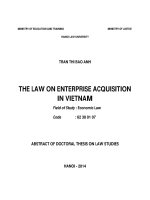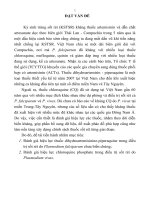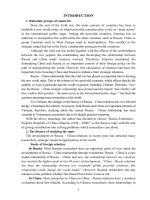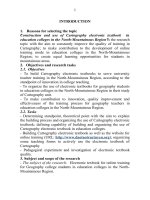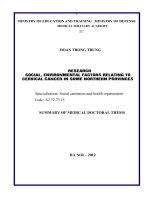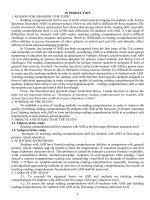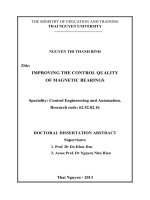NGHIÊN CỨU TÁC DỤNG KHÁNG UNG THƯ PHỔI NGƯỜI CỦA VIRUS VACCINE SỞI TRÊN THỰC NGHIỆM ttta
Bạn đang xem bản rút gọn của tài liệu. Xem và tải ngay bản đầy đủ của tài liệu tại đây (1.92 MB, 27 trang )
MINISTRY OF EDUCATION
MINISTRY OF HEALTH
AND TRAINING
HANOI MEDICAL UNIVERSITY
NGUYEN THI MY THANH
ANTI-CANCER EFFICACY OF VACCINE-STRAIN
MEASLES AGAINST HUMAN LUNG CANCER IN
EXPERIMENT
Speciality: Allergy and Immunity
Code: 62720109
(Bio-Medicine science Code: 9720101)
DOCTORAL THESIS
HANOI- 2023
THE THESIS WAS COMPLETED AT
HANOI MEDICAL UNIVERSITY
Supervisor:
1. Prof. Nguyen Linh Toan, MD. PhD.
2. Dr. Nguyen Van Do, MD. PhD.
The 1st reviewer: A/Prof. Dr. Nguyen Thi Xuan
The 2nd reviewer: A/Prof. Vu Xuan Nghia, MD.PhD
The 3rd reviewer: A/Prof. Luong Thi Lan Anh, MD.PhD
The thesis was defended in front of the thesis review
committee at Hanoi Medical University.
The thesis can be founded in:
- National library
- Military Medical Academy’s library
THE LIST OF PUBLISHCATION RESULTS
OF THE THESIS
1. Tạo khối ung thư phổi không tế bào nhỏ của người trên thực
nghiệm. Tạp chí nghiên cứu Y học Số 2. 2022 Trang (182188). />2. Hiệu quả kháng ung thư của virus sởi trên mơ hình chuột
thiếu hụt miễn dịch mang khối ung thư phổi người. Tạp chí
nghiên cứu Y học, Số 8 tháng 8 năm 2022. Trang (317 -323)
( />
1
INTRODUCTION
Lung cancer is the second most common cancer worldwide, after
breast cancer. According to statistics of the World Health
Organization (WHO), in 2020 there will be about 2.21 million of new
lung cancer cases and 1.8 million lung cancer deaths in the world.
Lung cancer remains a challenge for clinicians. The disease is often
detected at a late stage, the tumor is large and metastatic, the 5-year
survival rate is estimated at less than 18% for all stages of the
disease. More than 50% of cases of lung cancer diagnosis died in
duration of 1 year.
Oncolytic virus (OV) cancer therapy was introduced in the early
1990s and early 20th century. Many phase I-III clinical trials have
demonstrated good tolerability of OV therapy and a lot of promise.
Live, attenuated measles vaccine virus (MeV) has been shown anticancer effecacy in the treatment of several types of cancer: cutaneous
T-cell lymphoma, lung cancer, etc. with promising results.
In Vietnam, using MeV to treat cancer is a potential therapy that
is of interest to research. Recently, the Military Medical University
has studied the effecacy of MeV used alone and in combination to
treat many different lines of human blood cancer, the results showed
a clear anti-cancer effectiveness. To date, there have been no studies
to evaluate the effectiveness of MeV against human lung cancer.
From there, we carried out the project: “Study on Anti-cancer efficacy
of vaccine-strain measles viruses against human lung cancer in
experiment”.
Objectives
1. Assessment of cytotoxic efficacy and apoptosis of MeV in
human lung cancer (H460 and A549 cell lines) in vitro.
2. Assessment of anti-tumor efficacy of MeV against human lung
tumor in nude mice xenograft model bearing H460 cell tumor.
2
Essential and scientific meaning of the thesis
Studying anti-cancer efficacy of measles against human lung
cancer in vitro and in nude mice xenograft models, that can be a
premise for subsequent researches as well as clinical trials to evaluate
the safety and mechanisms of measles vaccine virus for lung cancer
treatment.
The new main contributions of the thesis
Completing the procedure of human lung cancer cell (H460 and
A549 cell lines) culture in vitro, transplanting H460 cell tumor under
thigh skin of nude mice.
Evaluation of the anti-tumor efficacy of MeV against human lung
cancer H460 and A549 cell lines in vitro and H460 cell line tumor
transplanted in nude mice xenograft model. From there, it forms the
basis for clinical trials of MeV for lung cancer treatmen.
Thesis layout:
The thesis has 130 pages, including: Introduction (2 pages),
Chapter 1: Overview (34 pages), Chapter 2: Subjects and methods
(28 pages), Chapter 3: Results (32 pages), Chapter 4: Discussion (31
pages), Conclusion (2 pages), Recommendations (1 page).
The thesis has 132 (English references: 130).
CHAPTER 1: OVERVIEW
1.1. Lung cancer
1.1.1. Current status of lung cancer in the world
In 2018, amount of Americans died from lung cancer was similar
these of a total of the next three most common cancers (colon, breast,
and prostate). In 2020, the overall incidence of lung cancer of men in
Europe is about 100/100,000, more than double the rate of women
(45/100,000).
3
1.1.2. Lung cancer status in Vietnam
In Vietnam, lung cancer is the most commonly diagnosed cancer
in men and the fourth most common cancer in women. From 2013 to
2017, the age-standardized rates for Hanoi and Ho Chi Minh City
were 32.03/100,000 population for men and 10.48/100,000 for
women. The 5-year survival rate for lung cancer is 14.8%.
1.1.3. Causes and risk factors for lung cancer
- Family history and gene variants
- Gene polymorphism
- Smoke
- Diet and alcohol consumption
- Chronic infections and other diseases
- Ionizing radiation
- Occupational exposure
- Air pollution
1.1.4. Classification of Lung Cancer
- Small cell lung cancer: Often associated with smoking, very
malignant.
- Non-small cell lung cancer: divided into 3 types
+ Adenocarcinoma
+ Squamous cell carcinoma
+ Large cell lung carcinoma
- Some other types of lung cancer
+ Bronchial carcinoids
+ Supportive tissue cancer in the lung
4
1.1.5. Pathogenesis of lung cancer
1.1.5.1. Pathogenesis of lung adenocarcinoma
There is a lot of evidence that there are at least two molecular
pathways, KRAS and EGFR, that cause lung cancer. EGFR
mutations, especially short deletion mutations in exon 19, L858R and
L861Q in exon 21. Other common point mutations and copy number
alterations (CNA) have been reported. described in LUAD and
examined in other regions of the gene.
A great deal of evidence to date has clearly shown surface-active
protein C expressed on LUAD-associated type II alveolar cells.
Recent work has shown that AAH is associated with the linear
progression of cells in the alveoli (respiratory terminal components)
to adenocarcinoma in situ and then to invasive LUAD, due to the
expression of genes common to alveolar cells and AAH. Loss of
heterozygosity (LOH) in chromosomes 3p (18%), 9p (CDKN2A), 9q
(1/TSC1 tuberous sclerosis complex), 17q and 17p (TP53) and
decreased expression of the block inhibitor tumor, serine threonine
kinase 11 (STK11 also known as LKB1).
Epigenetic alterations including DNA methylation of the
CDKN2A and PTPRN2 genes were also seen in AAH. In LUAD
disease, the NKX2-1 gene is frequently overexpressed or amplified
(position 14q13.3), which has a type II alveolar cell line-specific
oncogenic role for the transcription factor NKX2-1 in LUAD.
1.1.5.2. Pathogenesis of lung squamous cell carcinoma (LUSC)
Epithelial cells that lose alleles at multiple sites on chromosomes
3p (3p21, 3p14, 3p22–24 and 3p12) and 9p21 (CDKN2A) in the
bronchial epithelium are the earliest detected changes in the bronchial
epithelium. pathogenesis of LUSC. Allele imbalances at 8p21–23,
5
13q14 (RB1) and 17p13 (TP53) were also detected in pre-invasive
squamous cell lesions.
CDKN2A is methylated DNA in precancerous squamous lesions.
Vascular endothelial growth factor (VEGF) and VEGF receptors are
upregulated in bronchial squamous dysplasia lesions. Fatty acids and
retinoic acid, are also associated between pre-invasive squamous lesions
and LUSC. The oncogene SOX2 is amplified at position 3q26.3.
1.1.5.3. Pathogenesis of small cell lung carcinoma
The LOH at some chromosomal sites, the microscopic instability
of SCLC cells was significantly higher than that of neighboring
epithelium. SCLC is initiated by the inactivation of the TP53 and
RB1 genes, which activate the hedgehog signaling pathway. SCLC is
caused by specific changes in TP53 and RB1, repeat mutations in the
histone regulators CREBBP, EP300 and MLL as well as
amplification in the oncogene FGFR1.
1.1.6. Current treatment methods for lung cancer in Vietnam
1.1.6.1. Surgery
In recent years, there have been modern surgeries, including
laparoscopic video-assisted thoracic surgery (VATS).
1.1.6.2. Irradiation
- Stereotactic radiotherapy: Radiation therapy continues to evolve
and there are many modern techniques used to treat lung cancer.
- Radiofrequency/microwave: Used for early-stage peripheral lung
tumors or metastases in patients not indicated for surgery.
1.1.6.3. Targeted therapies and immune checkpoint inhibitors
Erlotinib inhibits EGFR, gefitinib inhibits PI3K/AKT/mTOR,
everolimus and entrectinib are NTRK/ROS1 inhibitors. Immune
checkpoint inhibitors (nivolumab and pembrolizumab)...
6
1.2. Measles vaccine virus therapy treats human lung cancer
1.2.1. Measles Virus Biology
Measles virus is a single-stranded, negative, enveloped RNA virus
of the morbillivirus genus and the family Paramyxovirus. (Figure 1).
Figure 1.1 Structure of measles virus
Source: Engeland C.E et al (2021)
(a) Measles virus; (b) Measles virus genome
nucleoprotein (N), Large Protein (L),
Phosphoprotein (P), Matrix (M),
Haemagglutinin protein (H), Fusion protein
(F), V and C nonstructural proteins.
1.2.2. Measles vaccine virus specifically infects lung cancer cells
1.2.2.1. Lung cancer cells have specific receptors for the measles virus
Since NSCLC cell lines strongly express MeV-specific CD46 and
Nectin-4 receptors, there is ample immunohistochemical evidence
that there is up to 40% of human NSCLC cell samples strongly
express CD46 and Nectin-4 receptors.
1.2.2.2. Mechanism of specific infection of cancer cells
Recent studies have demonstrated that MV‐Edm strains are
effective against lung cancer cells correlated with CD46 and Nectin-4
specific receptor expression levels.
* Cancer cells responds defectively to interferon
Lung tumor cells have defects in the antiviral interferon response
(IFN) pathway, making cancer cells more susceptible to viral
infeection than normal cells.
1.2.3. Mechanism lysing lung cancer cells of measles vaccine virus
1.2.3.1. Formation of syncytia (multinucleated giant cells)
MeV has F and H receptor-attaching proteins that involved in the
process of membrane fusion, the fusion between virus-infected cells
and neighboring normal cells to form syncytial cells (multinucleated
giant cells). A virus-infected cell can fuse with 50-100 neighboring
cells to form a syncytium.
7
1.2.3.2. MeV generates specific immunity against tumor cells
* Tumor cell death due to immune causes
MeV infection activates the innate immune system and lysis
MeV-mediated cancer cell has that has been confirmed in many
studies. There is growing evidence that MeV infection activates the
immune system to induce MeV-mediated cancer cell lysis. Pathogenassociated molecular pattern (PAMP) and Danger-associated
molecular pattern (DAMP), they trigger an specific immune response
against tumor cells.
MeV infection promotes antigen-presenting cell function and
effective initiation, activation of anti-tumor T-cell response.
MeV activates other components of the immune system against
cancer cells (Figure 1.2).
Figure 1.2. MeV activates the
immune system against tumor cells
* Source: G. Pidelaserra-Martí and
C.E. England (2020)
1.2.3.3. Modificating MeV enhances immunity against cancer cells
Modificating MeV was encoded by GM-CSF, FmIL-12, FmIL-15
(BiTEs… showed significant anti-tumor efficacy.
1.2.4. Host immune response against MeV
Anti-MeV antibodies have been shown to prevent MeV-mediated
tumor cell lysis, including local injection of MeV. However, more
extensive testing is needed than further evaluation.
8
1.5. The clinic trials using MeV and MuV for cancer treatment
Table 1.1. The clinic trials of MeV treat human cancer
1.
Viral
strain
MeVEZ
Route
Material,
of
dosage,
adminiduration
stration
Intratumoral
102–103
TCID50
Clinical
study and
patient
number (n)
Clinical outcomes
Author,
Year
phase 1
(n = 5)
One out of five complete
regression of injected lesion,
three out of five have regression
of injected lesions and two of
these patients also have
regression of distant lesion
Heinzerling
L et al
(2005)
phase 1
(n = 21)
14 out of 21 responses: mean 1year survival; one patient with
3.2-year survival
Galanis E
et al (2010)
phase 1
In progress
Multiple
myeloma
Phase 1
(n=2)
After only one viral infusion,
tumor-selective MV-NIS
replication was observed that led
to complete remission of a
disseminated malignancy in one
patient
Ovarian
Cancer
Phase 1
(n=16)
Disease
Subcutaneous T-cell
lymphoma
103–105
MeVIntraperit- TCID50 (4
Ovarian
CEA
oneal weeks/time
Cancer
6 moths)
MeV- IntratumGlioblastoma
CEA
oral
multiforme
MeVIntravenoNIS
us
MeVNIS
108–109
Intraperi- TCID50 (4
toneal weeks/time,
6 months)
MeV- IntraperitNIS
oneal
MeVNIS
Intratumoral
MeVNIS
Intratumoral
MeVNIS
Intratumoral
MeVCEA
MeVNIS
Intratumoral
Intratumoral
Pleural
mesothelioma
Squamous
cell
carcinoma of
the head,
neck
Peripheral
nerve sheath
tumour
multiple
myeloma
Ovarian,
fallopian and
peritoneal
cancer
Recurrent
Ovarian
Cancer
Median overall survival of 26.5
months 2015
Russell SJ
et al (2014)
Galanis E
et al (2015)
Phase 1
In processing
2012 -2018
Phase 1
(n=12)
In processing
2013 -2018
Phase 1
(n=30)
In processing
2017 -2021
phase 2
(n=16)
In processing
2015-2019
phase 1
(n=37)
In processing
2012- 2018
Phase 1
(n=54)
In processing
2014-2021
* Source: Pavlos Msaouel et al (2018)
9
2. CHAPTER 2: SUBJECTS AND METHODS
2.1. Subjects
2.1.1 Experimental animals and materials
Nude mice-BALB/c strain. Measles-Edmonton virus vaccine
strain, Vero cell, H460 and A549 cell lines. Eagle culture medium
(DMEM) supplemented with 10% heat inactivated fetal bovine serum
(FBS) and 1% antibiotic (penicillin and streptomycin) filter
sterilized, MTT kit; FITC Annexin V Apoptosis Detection kit (BD);
Fluorescence-bound antibodies.
2.1.2. Equipment
Caliper, camera, UV-VIS spectrophotometer for MTT assay, light
microscope, incubator with 5% CO2 atmosphere at 370 C, centrifuge,
flow cytometry system, transmission electron microscopy.
2.2. Research Methods
2.2.1. Culture and proliferation of cell lines in vitro
Vero, H460 and A549 cell lines were frozen in liquid nitrogen or at 80°C, quickly thaw vial (cryovial) of the cell line stocks. Transferring
the cell lines from the cryovial into plates containing completed DMEM
medium. When the cells grew, separating cells out by using 1X trypsinEDTA solution and transferring new culture plates.
2.2.2. Proliferation and titration of MeV
2.2.2.1. proliferation of MeV derived from virus vaccine
Infecting MeV into Vero cells, 7-8 days post-virus infection,
collecting MeV solution.
2.2.2.2. MeV titration using TCID50 assay
Seeding Vero cells into wells on 96-wells plate (104
cell/200µl/well). Infecting MeV into Vero cells on 96-wells plate
with viral dilution concentration of 10-2 to 10-9. At 5th day postinfection, using blue methylene as a colorant, calculating TCID50.
10
3.
TCID50 formula:
I: Proportionate distance (PD):
(% positive above 50%) – (50%)
(% positive above 50%) – (% positive below 50%)
II: (Log dilution% above 50%) (for example: log 10-3 is 3)
TCID50/ml = 10I+II/ml
2.2.3. Evaluation of MeV cytotoxicity by using MTT assay
Infecting MeV into HT-29 cells on 96-well plates with diluted
concentrations of 1MOI and 0.1MOI. On the 3rd, 4rd and 5rd day postinfection, putting MTT solution into the wells on 96-well plates,
measure the optical absorption (OD) at wavelength of 570 nm to read
the results and calculating the ratio of living cells in the wells.
2.2.4. Preparation of samples of virus-infected H460 and A549 cells
to evaluate apoptosis using flow cytometry analysis
Proliferating and seeding H460 and A549 cell lines into of 5 6wells plates. Infecting MeV into HT-29 cell wells on 6-well plates
with 1.MOI.
Collecting virus-infected cell samples in the wells on the 6-wells
plates at 3rd, 4rd and 5rd day post-infection.
2.2.5. Evaluation of apoptotic H460 and A549 cells using flow
cytometry analysis
MeV-infected H460 and A549 cells are processed and stained
according to the procedure instructions of the Fluorescein
isothiocyanate Annexin V Apoptosis Detection Kit. Evaluation of
apoptosis and necrosis cell rates on FACS CANTO II system (BD).
2.2.6. Nude mice husbandry
Nude mice- BALB/c strain were brought up in sterile rooms.
2.2.7. Transplantation of H460 cell tumors on nude mouse thighs
and calculating tumor sizes
Proliferation of HT-29 cells: preparing healthy nude mice, 6-8
weeks old of age. Injecting HT-29 cells with a concentration of 106
cells/mouse in subcutaneous mouse thighs.
Measuring tumor size: length and width by standard caliper.
Formula: V=D x R2/2 (mm3). V: volume; D: length; R: width
11
2.2.8. Treatment of nude mice bearing H460 cell tumor with MeV
There are 2 study groups (10 nude mice/1 group), including: MeVtreated group; PBS-treated control group. Injecting MeV directly into
tumors with doses of 107 PFU/time, twice a week for 3 weeks.
2.2.9. Assessment of efficacy of treatment with MeV
Monitoring healthy status of post-treatment nude mice: weight,
movement, stimulating response, skin color of nude mice, nude mice
droppings.
Comparing the mean tumor sizes of study groups after treatment.
Mean survival time, survival and death rates between the study groups.
2.2.10. Dissection for getting tumor tissues of post-treated nude mice
Dissecting to get the spleen and external tumor tissues (2-3 mm)
of MeV, MuV-post-treated nude mice, washing with PBS, (the tumor
tissues is put into the cell immobilizing solution is glutaraldehyte 2%
in the buffer cacodylate, pH = 7.3 to make ultrastructure specimens)
2.2.11. Process H460 cell tumor tissue into cell samples to evaluate
the rate of immune cells and apototic cell death by flow cytometry
Crush the tumor tissue, add 1X PBS solution. Incubate the
solution with Trypsin-EDTA 1X solution at room temperature for 2030 minutes, centrifuge at 5000 rpm for 5 minutes.
Add 1X PBS solution to the cell mass, mix well and filter through
a 70 µm filter, we get H460 cell solution of tumor tissue.
Use specific antibodies to assess the percentage of immune cells
in the tumor tissue.
2.2.12. Ultrastructural analysis of H460 tumor cell
Using transmission electron microscopy (JEM 1400, JEOL,
Japan) to Analyze HT-29 tumor cell ultrastructure.
2.2.13. Histopathological analysis of H460 cells transplanted on
nude mice
Dissection of 3 samples of H460 cell line tumor transplanted on
nude mice in each MeV treatment group and control group. Sending
specimens to the Pathology Department, 103 Military Hospital for
analysis according to the following steps:
- Pass the patient through different chemicals:
12
- Casting specimens in faraffin:
- Hematoxylin - Eosin staining:
2.13. Statistical analysis
Data were analyzed using the GraphPad Prism 5.0 and SPSS
software. Statistical significance was defined as p value <0.05.
CHAPTER 3: RESULTS
3.1. Growth proliferation of H460, A549 and Vero cell lines and MeV
A
B
A
A
C
B
Figure 3.1. H460 cells attached to the bottom
and grow
(A) at 10X lens; (B) at 20X lens; (C) at 40X lens
Figure 3.2. A549 cells attach to the bottom
and grow
(A) at 10X lens; (B) at 20X lens; (C) at 40X lens
C
B
C
Figure 3.3. Vero cells attach to the bottom
and grow
(A) at 10X lens; (B) at 20X lens; (C) at 40X lens
Figure 3.4. Vero cells infected with MeV
(A), MeV infection on day 3th; (B) MeV infection
on day 4th; (C), MeV infection on day 5-6th;
(D) MeV infection on day 7th
3.2. MeV titration using TCID50 assay with methylene blue
Figure 3.1. The result of TCIC50 titration
TCID50 của MeV= 5x106,5/ml
3.3. MeV lysed directly H460 and A549 cell lines in vitro
Figure 3.6. (A) H460 and A549 Virus-infected cells formed the syncytia
on day 3rd; (B) on day 4th; (C) on day 5th post-infection
13
Table 3.1. Viable cell rates on the 3rd day post-infection measured by MTT assay
Cell lines
H460
A549
Groups
n
Control (1)
MeV 1MOI (2)
MeV 0,1 MOI (3)
Control (1)
MeV 1MOI (2)
MeV 0,1 MOI (3)
12
12
12
12
12
12
Viable cell rate (%)
Mean ± SD
p
100
p2-1, 3-1, 2-3
49.09 ± 5.63
<0.05
68.08 ± 8.968
100
p2-1, 2-3 <0.05
85.26 ± 3.34
P3-1 >0.05
98.3 ± 18.34
Chart 3.1. Viable H460 cell rates on the 3rd
Chart 3.2. Viable A549 cell rates on the 3rd
day post-infection measured by MTT assay day post-infection measured by MTT assay
Table 3.2. Viable cell rates on the 4th day post-infection measured by MTT assay
Cell lines
H460
A549
groups
n
Control (1)
MeV 1 MOI (2)
MeV 0,1 MOI (3)
Control (1)
MeV 1 MOI (2)
MeV 0,1 MOI (3)
12
12
12
12
12
12
Chart 3.3. Viable H460 cell rates on the 4th
day post-infection measured by MTT assay
Viable cell rate (%)
Mean ± SD
p
100
p2-1, 3-1, 2-3
28,25 ± 1,9
<0,05
66,43 ± 7,12
100
p2-1, 2-3 <0,05
71,48 ± 12,37
P3-1 >0,05
96,93 ± 29,53
Chart 3.4. Viable A549 cell rates on the 4th
day post-infection measured by MTT assay
14
Table 3.3. Comparison of the viable rates of H460 and A549 cells according
to infected time
Cell
lines
H460
A549
The day postinfection
The 3rd day
The 4th day
The 3rd day
The 4th day
The 3rd day
The 4th day
The 3rd day
The 4th day
Dose
1 MOI
1 MOI
0,1 MOI
0,1 MOI
1 MOI
1 MOI
0,1 MOI
0,1 MOI
Viable cell rate (%)
Mean ± SD
49,09 ± 5,63
28,25 ± 1,9
68,08 ± 8,97
66,426 ± 7,12
85,26 ± 3,34
71,48 ± 12,37
98,3 ± 18,34
96,93 ± 29,53
p
p < 0,05
p > 0,05
p > 0,05
p > 0,05
Chart 3.5. Comparison of viable H460
cell rates according to infected times
Chart 3.6. Comparison of viable A549
cell rate according to infected times
Figure 3.7. Apoptotic cell results of MeVinfected H460 cells on day 3rd post-infection
(Q4) early apoptosis region; (Q2) late
apoptosis area; (Q1) necrotic cell region
Chart 3.7. The apoptotic cell rate of
MeV-infected H460 cells on the 3rd
day post-infection
15
4.
Figure 3.8. Apoptotic cell results of MeVinfected H460 cells on day 4th post-infection
5. (Q4) early apoptosis region; (Q2) late
apoptosis region; (Q1) necrotic cell region
Figure 3.9. Apoptotic cell results of infectedMeV H460 cells on day 5th post-infection
(Q4) early apoptosis region; (Q2) late
apoptosis region; (Q1) necrotic cell region
Chart 3.8. Apoptotic cell rates of
MeV-infectedH460 cells on the 4th
day post-infection
Chart 3.9. Apoptotic cell rates of
MeV-infected H460 cells on the
5th day post-infection
Chart 3.10.
Comparison of
apoptotic cell death
of virus-infected
H460 cells
according to
infected time
16
Figure 3.10. Apoptotic cell results of A549
MeV- infected cells on day 3rd post-infection
(Q4) early apoptosis region; (Q2) late
apoptosis region; (Q1) necrotic cell region
Chart 3.11. Apoptotic rates of A549
MeV- infected cells on the 3rd
day post-infection
Figure 3.11. Apoptotic results of A549 MeVinfected cells on day 4th post-infection
(Q4) early apoptosis region; (Q2) late apoptosis
region; (Q1) necrotic cell region
Chart 3.12. Apoptotic rates of
A549 MeV- infected cells on the
4th day post-infection
Figure 3.12. Apoptotic cell results of A549 MeVinfected cells on day 5th post-infection
(Q4) early apoptosis region; (Q2) late apoptosis
region; (Q1) necrotic cell region
Chart 3.13. Apoptotic cell rates of
A549 MeV- infected cells on the
5th day post-infection
17
Chart 3.14. Comparison
of apoptotic cell death
rates of virus-infected
A549 cells according to
infected time
3.4. MeV against H460 cell tumor in nude mouse xenograft models
Table 3.4. The H460 cell tumor transplanted under nude mouse thigh skin
The time after injection
Monitoring indicators
Number of tumor-baering
nude mice
Pecentage of tumor-bearing
nude mice
1st day
(n = 20)
4th day
(n=20)
7th day
(n=20)
10th day
(n=40)
12th day
(n=20)
0
12
20
20
20
0
60
100
100
100
Figure 3.13. Image of H460 cell tumors
transplanted under nude mouse thigh skin
and measuring tumor size.
Table 3.5. Monitoring health of nude mice groups
Assessment levels
Nomal
Poor level
20 mice
0
20 mice
0
20 mice
0
20 mice
0
Monitoring indicators
Movement
Stumulating responses
Droppings
Skine colour
Weight (gram)
100
MeV groups
p>0.05
Control groups
80
60
40
20
0
The day post-injection
1th
4th
8th
11th
15th
18th
22th
25th
28th
Chart 3.15. Weight changes of nude mice groups after treatment with MeV
18
Chart 3.16. Mean tumor sizes after treatment with MeV and MuV
(A): Comparing tumor size of the groups on the 1st day post-treatment
(B): Comparing tumor size of the groups on the 28th day post-treatment
Survival day
47±1.7
50
40
p=0.0001
30.3±2.41
30
20
10
0
MeV
Control
Chart 3.17. Survival time, survival-death rate of the study groups treated by MeV
Figure 3.14. Apoptotic cell results of H460
MeV- injected tumor cells
(Q4) early apoptosis region; (Q2) late apoptosis
region; (Q1) necrotic cell region
Chart 3.18. Apoptotic cell rates of
H460 MeV- injected tumor cells
Chart 3.19. The results
of immune cells in
MeV-injected H460
cell tumors
19
3.5. Ultrastructure Analysis of post-treated H460 tumor cells
n
6.
7.
8.
hn
n
n
n
hn
hn
hn
n
n
n
bt
bt
bt
bt
n
bt
bt
hn
n
hn
n
n
bt
Figure 3.15. Ultrastructural images of
Virus-noninjected H460 tumor cells
infection
n
Figure 3.16. Ultrastructural images of necrotic
H460 tumor cells after MeV injection.
injection
bq
n
bq
n
bq
hb
n
bq
hb
kb
n
n
n
n
n
n
n
9.
Figure 3.17. MeV entered into H460 10. Figure 3.18. Ultrastructural images of
MeV-injected tumor cells
11.apoptosis of H460 MeV- injected tumor cells
3.6. Histopathological results of H460 cell tumors transplanted on
nude mice after treatment with MeV
12.
Figure 3.19. Histopathological images
13.
of MeV-non injected H460 cell tumors
14.
cells
Figure 3.20. Histopathological images of
necrotic H460 MeV-injected cell tumors
CHAPTER 4: DISCUSSIONS
4.1. Proliferation of Vero, H460 and A549 cell lines in vitro
4.1.1. Vero cell line proliferation
Vero cells were cultured and maintained in DMEM medium
adding 10% FBS and 1% antibiotics (Figure 3.3).
4.1.2. Culture and proliferation of H460 and A549 cell lines
This study, we used H460 and A549 cell lines. These cell lines
were cultured and maintained in DMEM medium supplemented with
10% FBS and 1% antibiotics. The steps of sowing, maintaining and
harvesting cells we followed by the right process. H460 and A549
20
cells have been shown to retain the same CD46 and Nectin-4 surface
receptors as human lung cells.
4.2. Proliferatimg measles vaccine virus and TCID50 Titration
Firstly, proliferating Vero cells, then, infecting MeV into Vero
cells to proliferat MeV. Enders J.F. et al (1949) demonstrated that
this method is widely used for the proliferation of viruses. Virus
titration is an important step in the research. The most common is the
TCID50 method. Reed L.J. (1938) firstly described the TCID50 assay.
In 2001, LaBarre D.D et al came up with a complete formula for
calculating TCID50.
4.3. Cytotoxic effect of MeV on H460 and A540 cells in vitro
4.3.1. MeV Directly lysed H460 and A540 cells by forming syncytia in vitro
The study results showed that MeV lysised H460 and A549 cells
via forming syncytia on 3rd-6th day of infection in vitro, most clearly
at 3rd-5th day post-infection. MeV-infected cells produce widespread
syncytial (Figure 3.6). Syncytia usually die after a few days. E-H Lin
et al. (2009) also demonstrated that the viral membrane fusion
protein F induces fusion and lysis of human lung cancer cells in vitro.
4.3.2. Evaluation of the cytotoxic effect of MeV on H460 and A549
cells by MTT assay
The results showed that the percentage of H460 and A549 viable
cells in the two MeV-infected groups was lower (p<0.05) than those
of the control groups. In both A549 and H460 MeV-infected cells,
the survival rates of the MeV-infected group with 1 MOI was lower
(p<0.05) than the group with 0.1 MOI. The percentage of viable cells
decreased according to MeV infectious time for both the
concentrations of MeV infection. Our results are similar to those of
Yan Y et al (2015), used the MTT assay to assess cytotoxic effect of
wild-type and rL-RVG recombinant NDV virus on A549 cell line.
21
4.3.3. MeV induced apoptosis in H460 and A549 cell lines in vitro
MeV had the ability to lyse H460 and A549 cells in vitro
mediated by apoptosis. The rates of apoptosis, early apoptosis and
late apoptosis H460 and A549 MeV-infected cells were higher with
p<0.05 than those of the control groups. Our research results are
similar to those of Zhao D et al (2013).
4.4. MeV against H460 cell tumor on nude mice xenograft model
4.4.1. Evaluation of the toxicity of MeV on nude mice
The result shown that the weight of nude mice in the study groups
were almost unchanged. The difference was no statistical significance
(p>0.05) between the study groups. The indicators for evaluating
health of nude mice all were normal (Table 3.5).
4.4.2. Measles vaccine virus against H460 cell tumors transplanted
in immunodeficient mice
Before treatment with MeV, the difference of tumor sizes between
the control group and the MeV-injection group was not statistically
significant (p>0.05) (Figure 3.12A), similar to Le Duy Cuong's study
(2019). After treatment with MeV, the study demonstrated that The
mean tumor sizes of the MeV-treated groups increased more slowly
those of control group with p<0.05. The mean survival time of the MeVinjected group was longer and more number of survival mice of the
MeV-injected group than those of the control group (Figure 3.12B).
4.4.3. MeV stimulates specific immunity against H460 tumor cells
We use anti-CD11b, CD11c, CD49b and CD197 (CCR7) antibodies to
detect mice immune cells: myeloid leukemia cells, DCs, NK cells and mature
DCs, respectively. The results showed that the percentages of myeloid
leukemia cells, NK cells, DCs and mature DCs of the MeV-treated groups
(47.18±2.44%; 27.92±4.20%; 13.45±3.26%; 8.95±2.68% respectively) was
22
statistically significantly higher than those of control group (11.18±3.23%;
21,9±2,05%; 4.18±1.06%; 3.73±2.50% respectively).
4.4.4. MeV against H460 tumor cells via apoptosis pathway
The results showed that the rates of apoptosis, early apoptosis and late
apoptosis of MeV-injected H460 tumor cells were higher with p<0.05
than those of the control group (53.93±18.99% versus 22.53±5.92%),
(14.93±6.86% versus 0.88±0.35%), (39.0±12.98% versus 21,65±5.59%)
respectively. The results are similar to the study of Zhao D et al (2013).
4.4.5. Ultrastructure images of MeV-injected H460 tumor cells
Cells were close together, no intercellular space, extracellular matrix.
Appeared syncytia that were large size, nuclei condensing (chromatin
condensation at the cell periphery), nuclear fragmentation and formation
of apoptosis (Figure 3.16; 3.17; 3.18). Cells are destroyed, lose structure,
cell membranes and organelles, nuclear membranes lose continuity,
some cell nuclei lose nucleus, appear fishbone-shaped structures. H460
cells infected with MeV have a spherical granule structure - the virus is
forming on the cell membrane (Figure 3.17). In addition, there was
syncytia which are multinucleated huge cells (Figure 3.18).
4.4.6. Histopathological images of MeV-injected H460 cell tumor
The tumors had small necrotic foci between the tumor cell clusters
and a large central necrotic foci, the necrotic zone with cellular debris
and coagulated nuclei (Figure 3.20). Many studies have found that
MV-Edm lysed 50-70% of NSCLC cells without apoptosis due to
inactivation of caspase-3, followed by absence of poly (ADP-ribose)
glycohydrolase cleavage. These observations suggested that the anticancer efficacy of MV-Edm against NSCLC may not be solely
dependent on apoptosis.
